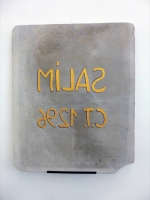Mare Nostrum
2013-2015
.
.
installation
.
mobile
gold leaves on fragments of small boats, wood, steel, rope
370 x 500 x 600 cm
coproduction MAC's, Grand-Hornu (Be)
paintings
acrylic on newspapers (Le Monde), ivory nails
47 x 32,5 cm
lithographic stones
acrylic on lithographic stones
variable dimension
.
.
Fragments of a boat float in the air. Pages of the newspaper Le Monde, motionless, are pinned to the walls by ivory nails. The insides of the fragments are covered in gold (leaf). So are the newsprint sheets of paper where chips of paint fallen from the boat fragments are fixed as well. Lithographic stones, too thin to support any kind of pressure, are transformed into tributes to all the anonymous people who have lost their lives in the waters, through the inscription of a name and ID number of a boat washed up or towed to the shores of the Italian island of Lampedusa.
The installation as a whole evokes the dramatic issue of immigration in the Mediterranean Sea, where thousands of migrants from the African continent, the Near East and Middle East, come to die every year. A symbol of capitalism and wealth of Western countries, built in part on colonialism, the gold illustrates the dream, the illusion of a better life in all these migrants’ minds, lost between sky and sea. Scratched by human nails directly on the gold leaf stuck to one of the fragments, an inscription in Arabic gives the dismantled boat its political status of a message in the bottle: We are 152 God help us. This number corresponds to the casualties in the shipwreck of French frigate The Medusa in 1816, famously known thanks to the painting by Theodore Gericault The Raft of the Medusa. Several references to Moby Dick by Herman Melville, the novelist of American mythology, can also be noted: The whalebone of Captain Ahab’s leg, the gold doubloon promised to the one who will spot the whale, Pip, the cook boy, who jumps overboard and finds himself stranded in the awful lonesomeness of the sea and finally succumbs to madness.
Since 2002, several thousands of refugees have lost their lives in the Mediterranean Sea.
.
.
Des fragments de barque flottent dans l'espace. Des pages du journal Le Monde, immobiles quant à elles, sont fixées aux murs par des clous en ivoire. L'intérieur des fragments est recouvert d'or (feuille) de même que les papiers journaux où sont également fixés des écailles de peinture tombées de ces fragments. Des pierres lithographiques, trop peu épaisses pour supporter une quelconque pression, sont transformées en hommage aux anonymes disparus dans les eaux à travers l'inscription d'un nom et d'un matricule d'une barque échouée ou remorquée sur l'île italienne de Lampedusa.
L'ensemble évoque le problème dramatique de l'immigration en mer méditerranée où périssent chaque année des milliers de migrants du continent africain, du Proche et du Moyen Orient. Symbole du capitalisme et de la richesse des pays occidentaux fondés entre autres sur le colonialisme, l'or illustre le rêve ou le leurre de tous ces migrants, entre ciel et mer. Griffé à l'ongle, à même la feuille d'or sur l'un des débris, une inscription en arabe donne à l'embarcation disloquée son statut politique de bouteille à la mer : Nous sommes 152 Que Dieu nous aide. Ce nombre correspond au bilan du naufrage de la frégate française La Méduse en 1816, devenue légendaire grâce au tableau de Théodore Géricault Le Radeau de la Méduse. Plusieurs références au livre Moby Dick de Herman Melville, le romancier de la mythologie américaine, y sont également décelables : l'ivoire de la jambe du capitaine Achab, la pièce d'or promise à la vigie qui repèrera la baleine, le petit Nègre Pippin qui tombe plusieurs fois à la mer, y reste longtemps et sombre finalement dans la folie.
Depuis 2002, plusieurs milliers de réfugiés se sont noyés en mer méditerranée.
.
.











